Recently, students from the university have been receiving good news
They are actively participating in various academic competitions
Striving to be the best and reaching new heights
Winning multiple national first prizes
Let’s take a look at their achievements
National College Student Electronic Design Competition
National First Prize
National College Student Electronic Design Competition
Co-hosted by the Department of Higher Education of the Ministry of Education and the Personnel Education Department of the Ministry of Industry and Information Technology
A total of 1134 ordinary higher education institutions from 31 provinces and cities across the country registered for the competition
Number of participating students: 62817
The school won 2 first prizes and 3 second prizes
Teams from the School of Computer Science and Engineering
and the School of Applied Technology won the national first prize

Introduction of Team Members from the School of Computer Science and Engineering
Chen Long, a 2020 undergraduate student majoring in Electronic Information Engineering at the School of Computer Science and Engineering, has accumulated rich practical experience in the laboratory and possesses excellent teamwork skills. He has a profound understanding of electronic technology and innovative capabilities, achieving outstanding results in the National College Student Electronic Design Competition, National College Student Intelligent Car Competition, National College Student Service Outsourcing Competition, and National College Student Mathematical Modeling Competition.

Cao Tianyu, a 2020 undergraduate student majoring in Electronic Information Engineering at the School of Computer Science and Engineering, is enthusiastic about participating in various electronic competitions and loves innovation. He has achieved excellent results in the annual College Student Electronic Design Competition and Computer Design Competition.

Wang Hou, a 2022 undergraduate student majoring in Software Engineering at the School of Computer Science and Engineering, actively participates in various research activities and academic competitions while maintaining excellent academic performance. He has achieved outstanding results in the Jilin Province College Student Electronic Design Competition, National College Student Cybersecurity Competition, and Xiangyun Cup competitions.

 Project Introduction
Project Introduction
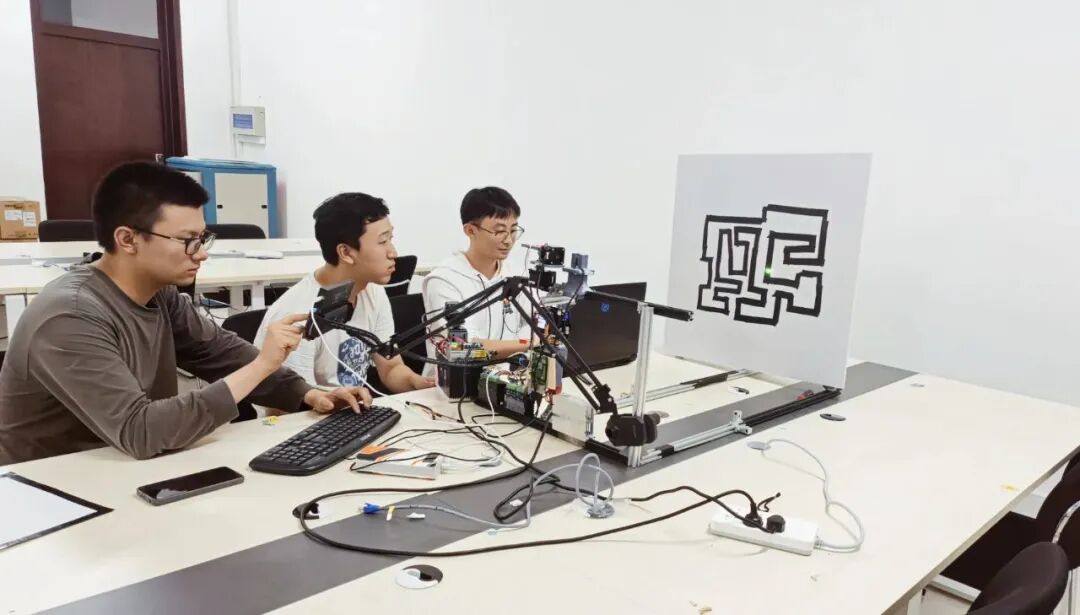
The project “Motion Target Control and Automatic Tracking System” guided by Teacher Cheng Chao won the national first prize in the National Electronic Design Competition in August 2023, with a national first prize winning rate of 2%. This project includes the control of the position of the red light spot indicating the target’s movement and the green light spot indicating automatic tracking. It constructs a two-dimensional gimbal and visual servo system based on dynamics and kinematics, providing higher precision for finding black motion trajectories and controlling the motion system.
The entire project consists of four key components: the main control system module, responsible for overall operation guidance and regulation; the two-dimensional electric gimbal, ensuring precise orientation and tracking functions; the motor drive module, controlling the rotation and tilt of the gimbal; and the camera module, providing real-time target data for precise tracking. The red gimbal is fixed at the center of the device, while the green gimbal is manually placed to change its position. The red gimbal uses data from the Raspberry Pi camera to manipulate the red laser pointer along a specified path, while the green gimbal uses data from OpenMV to achieve tracking of the red laser. The two systems operate independently without any communication. This dual-system design not only enhances the system’s flexibility and adaptability but also allows the two subsystems to be optimized for different tasks. Through PID control algorithms, the two systems can dynamically optimize and correct compensation, providing a certain level of system robustness to achieve precise identification and tracking under multiple disturbances.

Introduction of Team Members from the School of Applied Technology
Chi Haozhe, Zhang Hengyuan, Yu Yanpei are students majoring in CNC Technology at the School of Applied Technology, actively participating in various academic competitions while maintaining excellent academic performance. They won the national first prize in the TI Cup 2023 National College Student Electronic Design Competition and achieved outstanding results in the College Student Innovation and Entrepreneurship Training Program, National College Student Digital Modeling Competition, and the “Internet+” College Student Innovation and Entrepreneurship Competition.

 Project Introduction
Project Introduction

Guided by Teacher Fei Shuming, the design and production of a hovercraft driven by a high-speed axial flow fan for the 2023 National College Student Electronic Design Competition was completed. The hovercraft uses pneumatic reverse thrust principles and, with the assistance of a tracking module, achieves frictionless straight-line movement, specified curve navigation, hovering at designated positions, turning, and obstacle avoidance within the specified time. Additionally, the hovercraft can use a voice module to broadcast operational information, including: hovering time, cycle operation, number of obstacles avoided, and stable parking.
The design process utilized a central opening box body, rounded aluminum plates, and four small fan support structures printed with light-cured technology to form the basic framework. An Arduino Mega 2560 development board combined with its expansion board serves as the control platform. A large-capacity detachable rechargeable lithium battery provides power, and two independent step-down boards supply power to the entire vehicle. A high-power axial flow fan serves as the main power source, with four small fans as auxiliary power sources. A six-axis gyroscope acts as the primary information collection device, providing sensitive perception of subtle changes during movement, ensuring stable and precise steering. This allows the hovercraft to not only have a unique ability to hover stably but also to move flexibly.
China Graduate Electronic Design Competition
National First Prize
The 18th China Graduate Electronic Design Competition, guided by the Degree Management and Graduate Education Department of the Ministry of Education, had a total of 6289 participating teams from 333 universities and research institutes across eight major competition areas, with over 25000 teachers and students participating. Our school’s team from the School of Electrical and Electronic Engineeringwon the national first prize
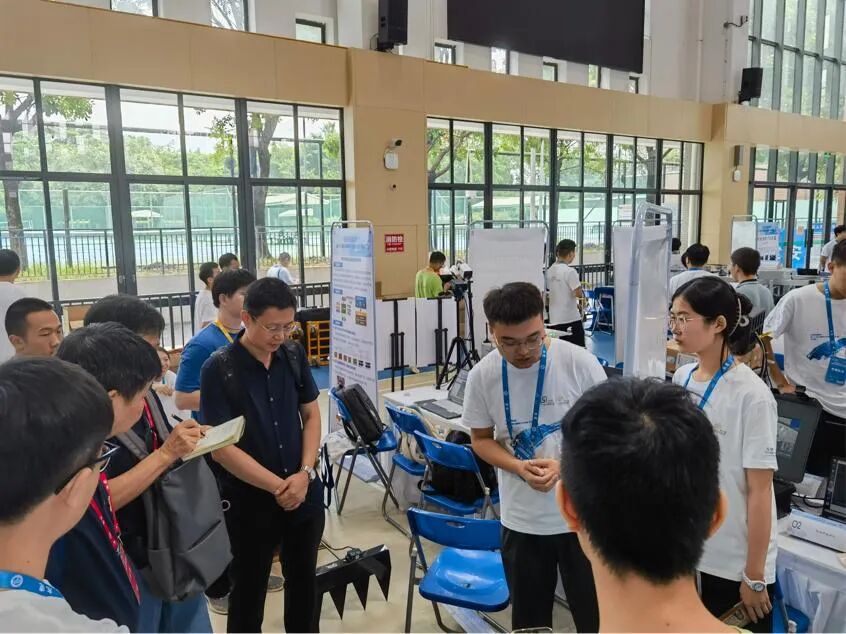

Introduction of Team Members from the School of Electrical and Electronic Engineering
Wu Hanyue, a 2022 master’s student majoring in Electrical Engineering at the School of Electrical and Electronic Engineering, is a member of the Communist Party of China. While maintaining excellent academic performance, he actively participates in various scientific competitions, achieving outstanding results in the Zhaoyi Innovation Cup China Graduate Electronic Design Competition and the National College Student Intelligent Car Competition.

Meng Linghang, a 2023 master’s student majoring in Electrical Engineering at the School of Electrical and Electronic Engineering, is a member of the Communist Party of China and currently serves as an assistant to the graduate counselor of the School of Electrical and Electronic Engineering. He has been awarded the title of “Top Ten College Students” in the School of Electrical and Electronic Engineering. While diligently completing student work, he actively enhances his technological innovation capabilities, winning the team first prize in the technical competition at the national finals of the 18th China Graduate Electronic Design Competition.
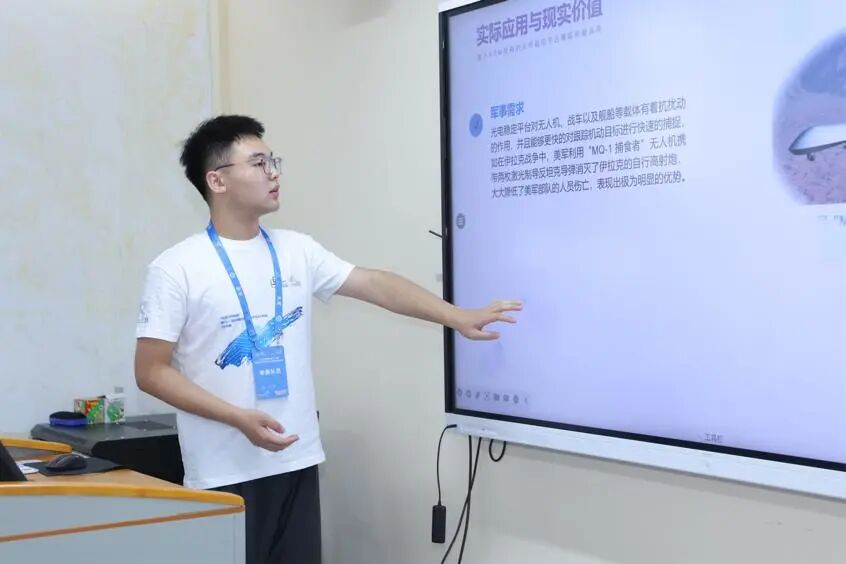
 Project Introduction
Project Introduction
The project “Optoelectronic Stabilization Platform Tracking Servo System Based on ARM Architecture” led by Teacher Han Shunjie aims to develop an optoelectronic tracking system that can achieve ultra-long distance, anti-interference, high precision, and strong stability in an ARM architecture environment. It innovatively approaches the design from the perspective of active anti-interference, researching synchronous online observation and disturbance suppression strategies, proposing a “lead-lag” correction combined with self-disturbance control algorithm to suppress complex disturbance factors of the optoelectronic tracking platform, improving the system’s steady-state response performance. By analyzing the characteristics of MEMS gyroscope signals, a dynamic model Kalman sliding mode filtering method, different from classical sliding mode filtering, is proposed, constructing a more systematic optimization system for gyroscope noise signal prediction and filtering. Based on a solid theoretical foundation, high-precision measuring components are combined with ARM architecture to construct a “position-velocity-current” three-loop control system, designing a servo control system with high precision and performance.
This achievement lays a theoretical foundation for solving the problems of multiple disturbances, poor stability, and low accuracy of optoelectronic stabilization platforms in moving carriers. It enables real-time monitoring and rapid tracking of targets during platform movement, meeting the modern requirements for long-distance, high maneuverability, and high precision reconnaissance and detection, with extensive applications in military reconnaissance, astronomical observation, and other fields.
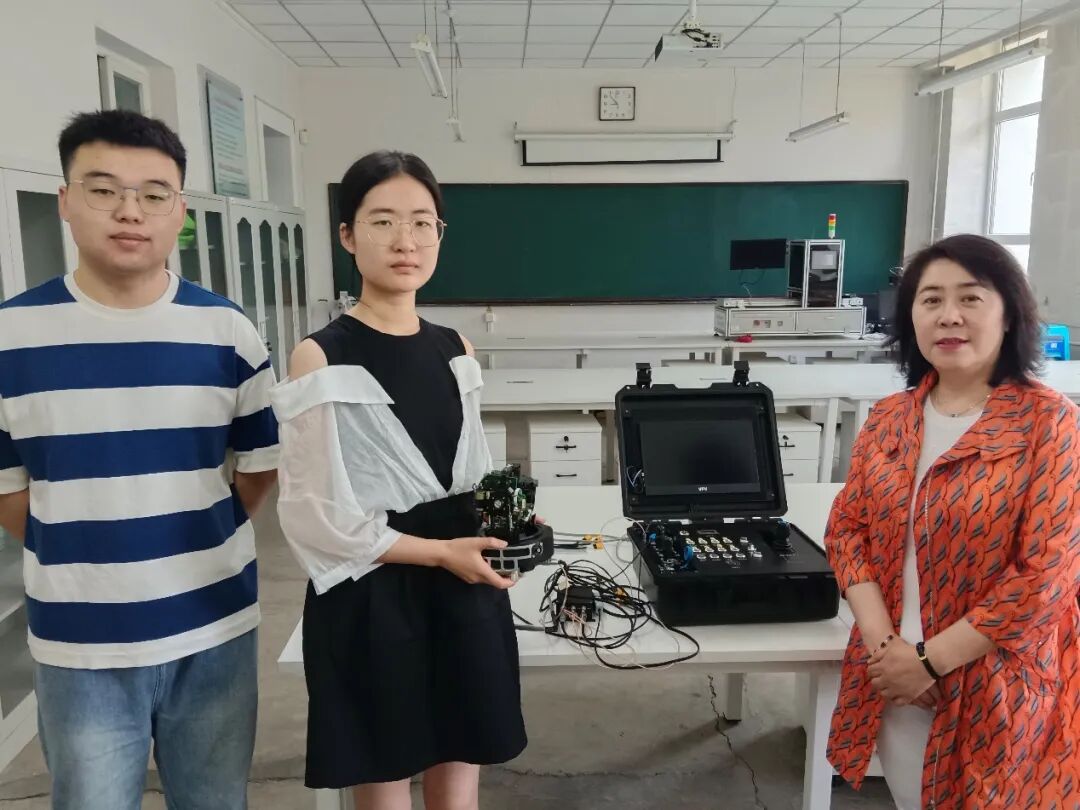
National College Student Chemistry Experiment Innovation Design Competition
National First Prize
The “Micro Rui Cup” Fourth National College Student Chemistry Experiment Innovation Design Competition
is hosted by the Chinese Chemical Society
and the National Experimental Teaching Demonstration Center for Higher Education of the Ministry of Education
with 1076 teams from 447 universities participating
Our school’s team from the School of Chemistry and Life Sciences won the national first prize

Introduction of Team Members from the School of Chemistry and Life Sciences
Li Zhaoyin, a 2021 student majoring in Chemistry at the School of Chemistry and Life Sciences, is a student leader and class monitor of Class 210705. He actively organizes or participates in various activities in the college, has organized and participated in volunteer services multiple times, and has been awarded the title of Excellent Student Cadre at Changchun University of Technology. As the person in charge, he participated in the National College Student Life Science Competition and won the national third prize; as the person in charge, he participated in the Micro Rui Cup National College Student Chemistry Experiment Innovation Design Competition and won the national first prize.

Liu Mengzhu, a 2021 student at the School of Chemistry and Life Sciences, is a member of the Communist Youth League. She has received the second-class scholarship once and the third-class scholarship once, actively participates in volunteer activities, and has won the national third prize in the National College Student Life Science Competition (Scientific Exploration category) and the national first prize in the “Micro Rui Cup” Fourth National College Student Experiment Innovation Design Competition.

Luo Shaoxiang, a 2021 student at the School of Chemistry and Life Sciences, is the class monitor of Class 210704, has received the third-class scholarship once, and has been recognized as an excellent volunteer once. As the person in charge, he participated in the Life Science Competition (Innovation and Entrepreneurship category) once and the Internet+ Competition once, and as a team member, he participated in the Life Science Competition (Innovation and Entrepreneurship category) once, winning the national third prize, and participated in the College Student Experiment Innovation Design Competition, winning the national first prize.

 Project Introduction
Project Introduction
The project “Capturing the Beauty of Nature – The Coordination Role Behind Dyeing” guided by Teacher Li Ming aims to popularize the concept of coordination and let people appreciate the beauty and interest of chemistry, while also recognizing the important applications of coordination in daily life. Coordination is an important concept in chemistry, representing the interaction between molecules, atoms, and ions, with compounds formed based on this force called coordination compounds. From ancient dyeing techniques to modern chemical processes and applications in daily life, coordination chemistry plays a significant role, yet public awareness of coordination chemistry is limited. This popular science experiment utilizes plant pigments (such as alizarin and hematoxylin) to dye plant fibers, showcasing the rich colors of coordination compounds formed by these pigments with metal ions; comparative experiments demonstrate the dyeing and fixing effects with and without coordination; and based on China’s intangible cultural heritage of tie-dyeing, original tie-dye works are presented, allowing people to appreciate the beauty of chemistry while experiencing the wisdom of artisans and the charm of Chinese craftsmanship.
Combining practical life, a home experiment plan is designed (using onion skins to make dye), making it easy for the public to conduct home experiments, reflecting the experiment’s promotability. Activities suitable for children, primary and secondary school students, college students, and the public are designed. This popular science experiment closely integrates chemistry, art, and culture, presenting visually appealing results, and the process is green, safe, and non-toxic.
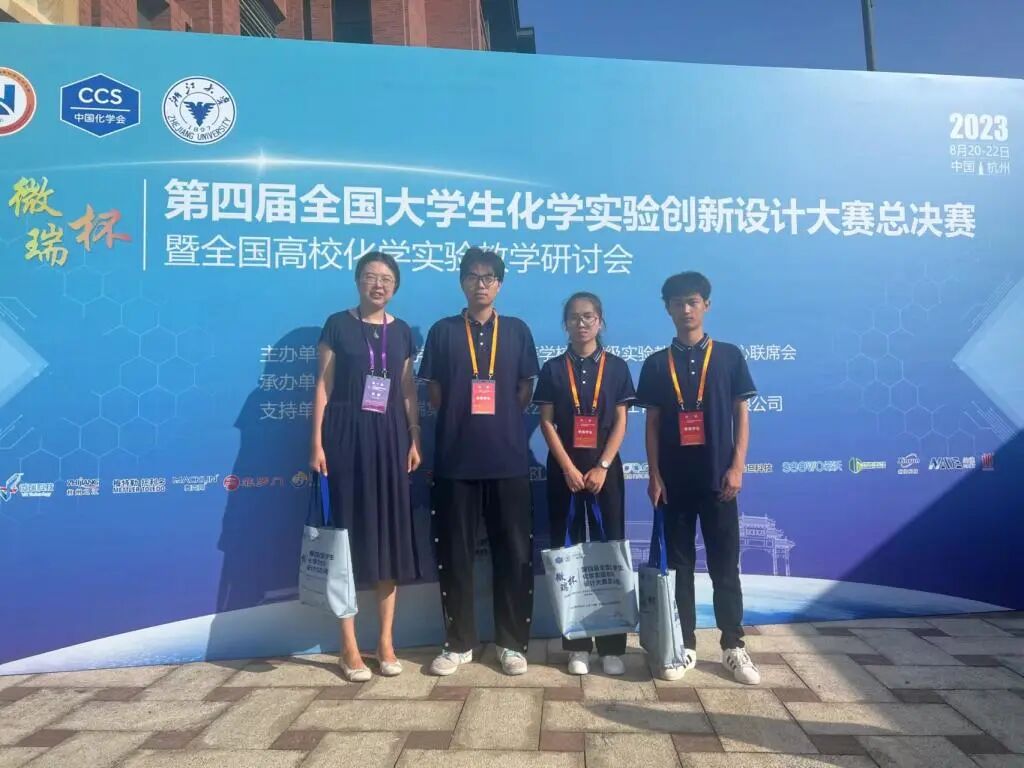
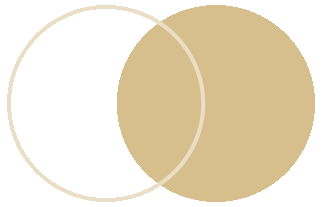
Patriotism and Dedication, Practical Innovation
We look forward to even better results from university students in various academic competitions in the future!
Go for it! Young people of the university!
Changchun University of Technology
Issue No. “2086”
Editor/Yan Kun
Director/Hou Shanshan
Proofreader/Gao Chunhong
Reviewer/Wang Yakun
Produced by/New Media Center Supervisor/Party Propaganda Department
